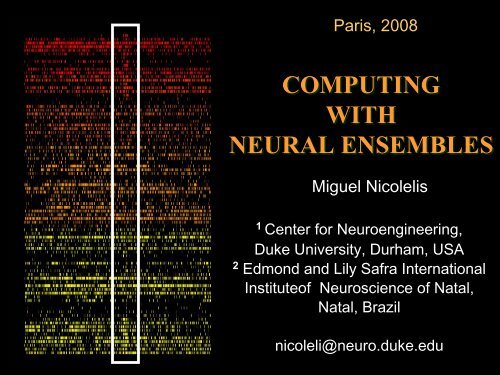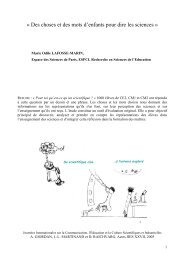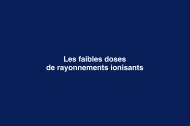Whisker Twitching - Espci
Whisker Twitching - Espci
Whisker Twitching - Espci
Create successful ePaper yourself
Turn your PDF publications into a flip-book with our unique Google optimized e-Paper software.
Paris, 2008<br />
COMPUTING<br />
WITH<br />
NEURAL ENSEMBLES<br />
Miguel Nicolelis<br />
1 Center for Neuroengineering,<br />
Duke University, Durham, USA<br />
2 Edmond and Lily Safra International<br />
Instituteof Neuroscience of Natal,<br />
Natal, Brazil<br />
nicoleli@neuro.duke.edu<br />
1
Donald O. Hebb<br />
1949: The Organization of Behavior<br />
“…the cell assembly .[is] a diffus<br />
structure comprising [brain] cells<br />
In the cortex and diencephalon,<br />
capable of acting briefly as a<br />
closed system, delivering<br />
facilitation to other such<br />
systems..”
DEFINING THE PRINCIPLES OF<br />
NEURAL ENSEMBLE PHYSIOLOGY<br />
n What is the minimal neural ensemble size<br />
required to sustain a given behavior?<br />
n How does its membership vary from<br />
moment to moment?<br />
n What factors influence its dynamics?<br />
n Can different ensembles produce the<br />
same behavior?<br />
n Can the same ensemble yield multiple<br />
outputs?
John Lillie: an early attempt<br />
625 macroelectrodes<br />
Implanted in a Rhesus monkey<br />
“Carving Brain Activity”
HIGH DENSITY MICROWIRE ARRAYS
Implanting mice
Movable Microwire Array for<br />
Cortical and Subcortical Recodings
PROBING A NEURAL SYSTEM:<br />
THE NEW WAY<br />
CHRONIC IMPLANTS<br />
MULTIPLE<br />
ELECTRODES<br />
MULTIPLE SITES
NEURAL ENSEMBLE DATA ANALYSIS STRATEGY
� SOMATOSENSORY<br />
� MOTOR<br />
� GUSTATORY<br />
� LIMBIC<br />
Mouse = 30-70 neurons<br />
Rat = 100-200 neurons<br />
NEURAL SYSTEMS INVESTIGATED<br />
IN DIFFERENT SPECIES<br />
� SOMATOSENSORY<br />
� MOTOR<br />
Owl Monkey = 100-200 neurons<br />
Rhesus Monkey = 300-500 neurons<br />
� MOTOR<br />
(acute recordings)<br />
Human = 50 neurons
EXPERIMENTAL MODEL:<br />
THE RAT TRIGEMINAL SOMATOSENSORY SYSTEM
Single Trial, Aperture Width<br />
Discrimination<br />
Narrow Aperture Wide Aperture
THE MAP<br />
layer IV
THE RAT TRIGEMINAL<br />
SOMATOSENSORY SYSTEM AND ITS<br />
MAPS<br />
C2<br />
The Classical Model
Simultaneous, Multi-site, Neural Ensemble Recordings
SIMULTANEOUS, MULTI-SITE<br />
NEURAL ENSEMBLE RECORDINGS<br />
Nicolelis et. al., Science 1995
DISTRIBUTED PROCESSING OF TACTILE INFORMATION<br />
IN THE RAT SI CORTEX
SPATIOTEMPORAL RECEPTIVE FIELDS OF SI NEURONS<br />
Ghazanfar and Nicolelis, Cerebral Cortex, 1999.
DYNAMIC RECEPTIVE FIELDS:<br />
MAIN FEATURES<br />
� CORTICAL AND SUBCORTICAL (SI and VPM).<br />
�OBSERVED IN THE SOMATOSENSORY, VISUAL,<br />
AUDITORY, AND TASTE SYSTEMS.<br />
�FORMED BY THE ASYNCHRONOUS CONVERGENCE<br />
OF BOTH FEEDFOWARD AND FEEDBACK PATHWAYS.<br />
�BOTH SPATIAL AND TEMPORAL DOMAINS ARE<br />
SHAPED BY EARLY SENSORY EXPERIENCE.<br />
�PROVIDE THE POTENTIAL FOR IMMEDIATE PLASTIC<br />
REORGANIZATION FOLLOWING PERIPHERAL INJURY.<br />
Nicolelis et. al. Science, 1995.<br />
Ghazanfar and Nicolelis. Cerebral Cortex, 2001.
Active<br />
Exploration<br />
Quiet<br />
Waking<br />
LFPs and behavioral states<br />
<strong>Whisker</strong> <strong>Twitching</strong><br />
(Mu rhythm)<br />
Slow wave<br />
sleep<br />
Paradoxical<br />
/REM sleep
Power<br />
Spectrum<br />
Density<br />
Ratio1:<br />
0-20 Hz<br />
————<br />
0-55 Hz<br />
Ratio2:<br />
0-4 Hz<br />
————<br />
0-10 Hz<br />
Frequency (0-55Hz)<br />
Power<br />
ratio<br />
Frequency (0-55Hz)<br />
Power<br />
ratio<br />
Frequency (0-10Hz)<br />
0.9<br />
0.8<br />
0.7<br />
0.6<br />
0.5<br />
0.6<br />
0.5<br />
0.4<br />
4<br />
sec<br />
1 sec step<br />
Cortical LFP (100 sec, 500Hz sampling)<br />
Blue: raw power ratio<br />
Red: smoothed with Hanning(20) window
PC1 from<br />
Ratio1 of<br />
all LFPs<br />
from Cx,<br />
Th, Hipp,<br />
CPu<br />
PC1 calculated<br />
from Ratio2 of<br />
all LFPs<br />
THE “GREAT ATTRACTOR”
<strong>Whisker</strong> <strong>Twitching</strong><br />
During REM<br />
<strong>Whisker</strong> <strong>Twitching</strong><br />
During μ Rhythm<br />
THE GREAT ATTRACTOR<br />
AND ITS BEHAVIORS<br />
Slow Wave<br />
Sleep<br />
Whisking
THE GREAT ATTRACTOR DEPICTS ALL MAJOR<br />
RAT BEHAVIORAL STATES<br />
Mu<br />
Intermediate<br />
Sleep<br />
REM<br />
Active<br />
SWS<br />
Quiet<br />
Intermediate Sleep<br />
REM Sleep<br />
Slow Wave Sleep<br />
Quiet Awake<br />
Active Awake<br />
Mu State
2DMaps-3
THE GREAT ATTRACTOR CAN BE USED TO<br />
QUANTIFY TRAJECTORIES BETWEEN THE<br />
MAJOR BEHAVIORAL STATES<br />
Mu<br />
Intermediate<br />
Sleep<br />
REM<br />
Active<br />
SWS<br />
Quiet<br />
Intermediate Sleep<br />
REM Sleep<br />
Slow Wave Sleep<br />
Quiet Awake<br />
Active Awake<br />
Mu State
S1<br />
Figure S1.<br />
Diagrams of spontaneous transitions between behavioral states for 120 hours of a rat’s life, determined by the classical classification approach<br />
combining the observation of the overt behavior and analysis of LFP spectral features (Timo-Iaria et al., 1970; Winson, 1974; Fanselow and<br />
Nicolelis, 1999). Each state is represented by a circle, with area proportional to the amount of time spent in that state (% indicated in italic).<br />
Arrows indicate transitions from one state to another. Non-italicized numbers represent the relative occurrence probability of specific transitions.<br />
In agreement with previous studies, we found that rats spent ~60% of the day (light period) sleeping, and ~60% of the night (dark period) awake.<br />
Some state transitions are highly prevalent (e.g. AE↔QW, QW↔SWS, QW↔WT, SWS→REM and REM→QW), while others are either very<br />
rare (SWS→AE, REM→AE and WT→AE) or absent (SWS→WT and AE→REM). REM episodes are nearly always terminated by QW.
WT<br />
IS<br />
The Hypno-map<br />
REM<br />
SWS<br />
QW
TransitionsLength
Transitions
Figure 3. The topography of the two-dimensional state-spaces is consistent across animals. (A) Scatter plots of the 2-D state-space<br />
(conventions as in Fig. 2A). For all animals, 48 hours of recording are displayed; to avoid graphic saturation, only 20% of the data points were<br />
evenly sampled and plotted. (B) Density plots, calculated from the scatter plots, show the conserved cluster topography and the relative<br />
abundance of various states (see also Fig. 1D). (C) Speed plots representing the average velocity of spontaneous trajectories within the 2-D state-<br />
space. Stationarity (low speed) can be observed within the three main clusters, while a maximum speed is reached during transitions from one<br />
cluster to another, i.e. between brain states.
Pooled Coherence (S1, VPM, Hippocampus, Striatum)
6<br />
Figure 6. Pooled coherence, a single measure to address the dynamic of global brain states. 3-D state-space in four rats derived from to<br />
the two amplitude ratios (X and Y axes), and the additional average pooled coherence between 7-55 Hz (Z- axis). The use of pooled<br />
coherence as a single measure of the coupling between forebrain areas captured state-dependent patterns and further improved the<br />
separation between states. Notice that the WT cluster can be easily identified.
CONCLUSIONS – PART I<br />
� A large scale dynamic structure can be identified by combining simultaneously<br />
recorded LFP activity in the SI cortex, VPM thalamus, hippocampus, and striatum.<br />
� Different regions of this dynamic structure correspond to distinct behavioral<br />
states and transitions between states.<br />
� Transitions between states are characterized by the occurrence of transient<br />
periods of high coherence between cortical, thalamic, hippocampal, and striatal<br />
LPF activity. By combining the duration, level of pooled coherence, and phase of<br />
these brief periods of high coherence one may identify the behavioral state the<br />
animal was departured from and the likely state the animal will attain.
Behavioral States Investigated<br />
Quiet:<br />
no movement<br />
Active:<br />
Body movement not involving<br />
whiskers<br />
Whisking:<br />
large-amplitude exploratory<br />
whisker movements<br />
<strong>Whisker</strong> <strong>Twitching</strong>:<br />
small-amplitude, rhythmic<br />
whisker movements
STIMULATION AND<br />
RECORDING<br />
METHODS<br />
MICROWIRES<br />
VPM<br />
SI<br />
SURGICAL<br />
SUTURE<br />
CUFF ELECTRODE<br />
TEFLON-COATED<br />
WIRES<br />
PLATINUM<br />
BANDS<br />
SYLGARD<br />
1 mm<br />
Fanselow and Nicolelis. J. Neurosci. 1999
RESPONSES TO ELECTRICAL NERVE CUFF STMULATION<br />
VS. MANUAL WHISKER DEFLECTION<br />
SINGLE UNIT<br />
MULTI-UNIT<br />
CLUSTER<br />
80<br />
40<br />
0<br />
80<br />
40<br />
NERVE CUFF<br />
STIMULATION<br />
MANUAL WHISKER<br />
DEFLECTION<br />
0<br />
-50 0 50 -50 0 50 ms
SPIKES/SEC<br />
200<br />
100<br />
0<br />
200<br />
100<br />
0<br />
BEHAVIORAL MODIFICATION OF TACTILE RESPONSES<br />
IN SINGLE UNITS<br />
VPM THALAMUS<br />
SI CORTEX<br />
QUIET ACTIVE WHISKING WHISKER<br />
TWITCHING
BEHAVIORAL MODIFICATION OF TACTILE RESPONSES<br />
IN SINGLE UNITS<br />
100<br />
INTEGRATED<br />
MAXIMUM<br />
RESPONSE MAGNITUDE<br />
50<br />
0<br />
100<br />
50<br />
0<br />
VPM THALAMUS SI CORTEX<br />
*<br />
*<br />
Q A W WT Q A W WT<br />
*<br />
*<br />
*<br />
*
QUIET<br />
ACTIVE<br />
WHISKING<br />
WHISKER<br />
TWITCHING<br />
MODULATION OF POST-STIMULUS INHIBITION<br />
BY BEHAVIORAL STATE<br />
40<br />
20<br />
0<br />
40<br />
20<br />
0<br />
40<br />
20<br />
0<br />
40<br />
20<br />
0<br />
VPM THALAMUS SI CORTEX<br />
0 50 100 150 200 0 50 100 150 200<br />
MSEC<br />
SPIKES/SEC
MAXIMUM<br />
MAGNITUDE<br />
INTEGRATED<br />
RESPONSE<br />
150<br />
100<br />
50<br />
0<br />
150<br />
100<br />
50<br />
0<br />
BEHAVIORAL MODULATION OF RESPONSES TO<br />
PAIRED STIMULI IN RAT SI CORTEX<br />
QUIET ACTIVE WHISKING<br />
1st 50 100 150 200 1st 50 100 150 200 1st 50 100 150 200<br />
2nd stimulus<br />
ISI IN MSEC
BURST FIRING IN VPM THALAMUS<br />
quiet whisker twitching<br />
Fanselow et. al. PNAS, 2001
TONIC AND BURSTING MODES<br />
(Jahansen and Llinas 1984, McCormick 1992, Sherman and Guillery 1996)
SI<br />
SI<br />
VPM<br />
VPM<br />
Field potential recordings<br />
during the whisker twitching<br />
behavior<br />
SI<br />
SI<br />
VPM<br />
VPM
High Sensitivity Correlated with <strong>Whisker</strong> Movements<br />
Fanselow<br />
et al. 2001<br />
Nicolelis<br />
et al. 1995<br />
Facilitated detection of novel or faint stimuli during bursting mode: Guido and Weyand 1995
7-12Hz Oscillations (μ rhythm) tend to spread<br />
from the SI cortex to the VPM thalamus
SI<br />
VPM<br />
SI Inactivation Abolishes VPM bursting during <strong>Whisker</strong> <strong>Twitching</strong><br />
SI INTACT<br />
SI BLOCKED<br />
SI INTACT<br />
SI BLOCKED
CONCLUSIONS PART II<br />
� THE PHYSIOLOGICAL PROPERTIES OF BOTH THALAMIC<br />
AND CORTICAL NEURONS ARE DETERMINED BY THE<br />
ANIMAL’S BEHAVIORAL STATE.<br />
� WE PROPOSE THAT BOTH CELLULAR PROPERTIES AND CIRCUIT<br />
INTERACTIONS IN THE RAT THALAMOCORTICAL LOOP SHIFT IN PARALLEL<br />
WITH CHANGES IN THE ANIMAL’S EXPLORATORY STRATEGY.<br />
� IN THIS MODEL, DURING QUIET AND WHISKER TWITCHING STATES, THE<br />
PHYSIOLOGICAL PROPERTIES OF THE THALAMOCORTICAL ARE<br />
OPTIMIZED FOR DETECTION OF NOVEL OR SMALL TACTILE STIMULI.<br />
� CONVERSELY, DURING WHISKING, THALAMIC AND CORTICAL NEURONS<br />
BECOME OPTIMIZED TO PROCESS INFORMATION DERIVED FROM FAST<br />
SEQUENCES OF MULTI-WHISKER STIMULI, WHICH UNDERLIE THE ANIMAL’S<br />
ABILITY TO DISCRIMINATE MULTIPLE TACTILE ATTRIBUTES OF AN OBJECT.
TACTILE DISCRIMINATION TASK
TACTILE DISCRIMINATION OF THE APERTURE WIDTH<br />
REQUIRES MULTIPLE WHISKERS
TASK COMPLETION REQUIRES THE SI CORTEX
BEHAVIORAL PERFORMANCE OVER TIME
Chronic Recordings in Multiple Cortical Layers<br />
RAT<br />
“BARREL”<br />
SI<br />
CORTEX<br />
Layer II/III<br />
Layer IV<br />
Layer V
NEURAL ENSEMBLE DATA ANALYSIS STRATEGY
Active Vs. Passive Discrimination
SI NEURONS HAVE BILATERAL<br />
RECEPTIVE FIELDS<br />
Shuler, Krupa, and Nicolelis. J. Neurosci. 2001.
CONCLUSIONS – PART III<br />
• Tactile cortical responses during active exploration of objects are very<br />
distinct from those observed in anesthetized or even immobilized rats.<br />
• Inhibition may play an important role in the representation of bilateral<br />
tactile stimuli during active whisker discrimination.<br />
• Different types of inhibition patterns are seen in the rat S1 cortex. Different<br />
layers exhibit a predominance of distinct patterns of inhibition.<br />
• Callosal interactions may account for some of the inhibition observed<br />
during integration of bilateral whisker stimuli.<br />
• Other afferents may contribute to other types of inhibitory effects (long-<br />
inhibition) that account for sensory gating of tactile signals during active<br />
whisker exploration
ROBUST TACTILE<br />
RESPONSES<br />
IN THE RAT<br />
DORSAL<br />
HIPPOCAMPUS<br />
Pereira at. al., PNAS 2007
MUSCIMOL INJECTION<br />
S1<br />
MUSCIMOL INJECTION<br />
VPM THALAMUS<br />
MUSCIMOL INJECTION<br />
S1<br />
TACTILE REPONSES IN THE RAT<br />
DORSAL HIPPOCAMPUS<br />
DEPEND ON SOMATOSENSORY<br />
LEMNISCAL PATHWAY<br />
MUSCIMOL INJECTIONS<br />
S1 AND VPM
Pereira at. al., PNAS 2007<br />
Perforant
Pereira at. al., PNAS 2007<br />
active
HIPPOCAMPAL ENSEMBLE ACTIVITY<br />
PREDICTS OUTCOME OF<br />
TACTILE DISCRIMINATION TASK<br />
Pereira at. al., PNAS 2007<br />
• Differences on neuronal<br />
ensemble activity as a<br />
function of task<br />
performance<br />
• Learning Vector<br />
Quantization (LVQ) –<br />
non-parametric statistical<br />
pattern recognition.<br />
• Implemented on an<br />
Artificial Neural Network<br />
• M. Laubach, J. Wessberg, M. A. Nicolelis,<br />
Nature 405, 567 (2000).
COLLABORATORS<br />
DUKE UNIVERSITY<br />
DEPT. NEUROBIOLOGY<br />
• DAVID KRUPA, Ph.D.<br />
• MICHAEL WIEST, Ph.D.<br />
• SIDARTA RIBEIRO, Ph.D.<br />
• DAMIEN GERVASONI, Ph.D.<br />
• SHIH-CHIEH LIN<br />
• ANTONIO PEREIRA<br />
• GARY LEHEW
COLLABORATORS<br />
DUKE UNIVERSITY<br />
DEPT. NEUROBIOLOGY<br />
• David Krupa, Ph.D.<br />
• Erika Fanselow, Ph.D.<br />
• Marshall Shuler, Ph.D.<br />
• Sidarta Ribeiro, Ph.D.<br />
• Damien Gervasoni, Ph.D.<br />
• Janaina Pantoja<br />
• Gary Lehew<br />
• Laura Oliveira, M.D.




